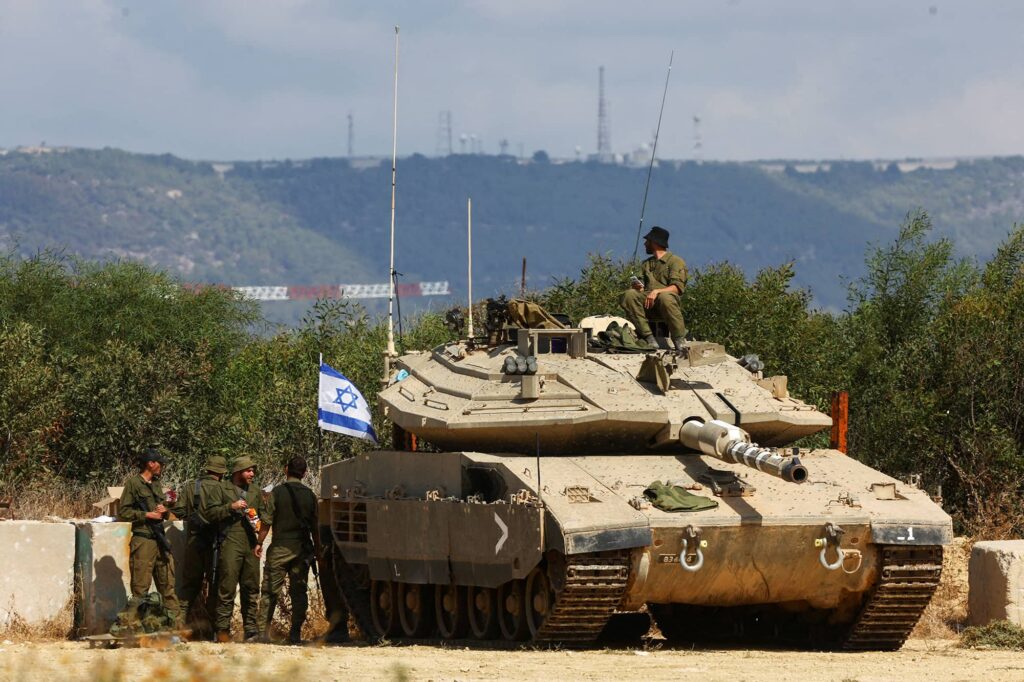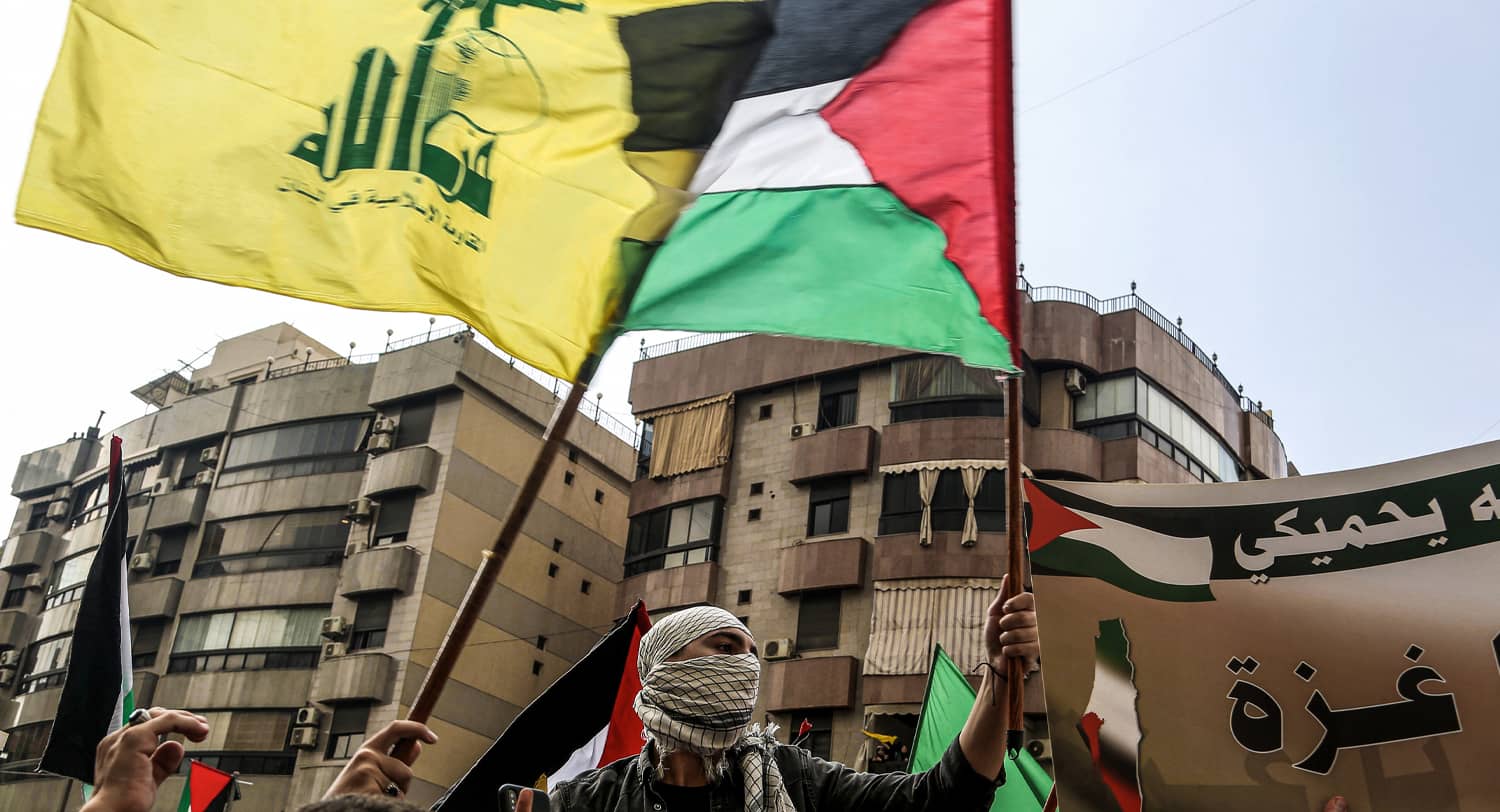The danger of today’s conflict in Gaza becoming a two-front war for Israel depends on a range of issues, most importantly Lebanese Hizbullah’s leadership and capabilities, the strategic aims of Hizbullah’s patron, Iran, and the actions of Israel and the United States to effectively deter escalation.
Hizbullah as an organization plays three different roles at the same time:
Ideologically, it is fully invested in Ayatollah Khomeini’s version of Shi’ite Islam, and adheres to the policy orientation set forth by Iran’s present Supreme leader, Ali Khamene’i – in effect, Tehran’s most powerful and most loyal proxy in the Middle East, with the ultimate destruction of Israel as a major tenet of its faith.
Politically, it is the dominant party of Shi’ites of Lebanon, which are now the largest of the country’s confessional groups. While HIzbullah suffered a setback in the latest parliamentary elections, and have failed so far to elect a president of their choice, the party still has veto power on national decisions and in national institutions.
Militarily, it is the most powerful force in Lebanon – far exceeding the Lebanese Army, which Hizbullah humiliated in May 2008 and has intimidated ever since. It has a sophisticated raiding unit – the Radwan Force; anti-tank weapons of Syrian (i.e., Russian) provenance; drones and UAVs; air defense and offensive cyber capacities; and above all, a massive array of rockets and missiles of various ranges, estimated at some 150,000 in number, covering most if not all of Israel, some with precision guidance.
Immediately following Hamas’ October 7 attack on the Gaza border, Hezbollah mobilized in a parallel escalatory cycle on Israel’s border with Lebanon. The first shot was fired by Hizbullah, who broke the relative quiet in the north on the second day of the war, 8 October. It fired rockets into the slopes of Har Dov – in what they openly described as an act of solidarity with the Palestinian struggle, while also paying lip service to the call for the liberation of “occupied Lebanese territory” (an area, known as Sheba’a Farms, claimed by Hizbullah as Lebanese, although it was under Syrian rule until taken by Israel in 1967). Israel responded with artillery fire. From that point onwards, local exchanges of fire have taken place all along the border, with tensions steadily rising.
These incidents involve both Hizbullah and Palestinian elements operating from Lebanon. Since October 14, both the number of incidents and their intensity has significantly increased. Despite the escalation, Hizbullah’s attacks remain limited and focused. It claims to be targeting only military positions and assets (although civilian targets have been hit). and seeks to maintain a “retaliatory equation” balancing their losses with attacks on Israel. An example of this symmetrical practice came when Hizbullah struck the cameras and technical equipment on the Israeli border fence – in retaliation for IDF strikes against Hizbullah watch towers. This was literally an eye for an eye. This was followed by several instances in which anti-tank missiles were fired into Israel, some of them causing casualties There were also several infiltration attempts by Palestinian groups, supported by Hizbullah, who tried to cross the border but were detected and destroyed.
On 19 October, Hamas in Lebanon took responsibility for what they claimed was a 30-rocket barrage aimed at various towns in northern Israel, which could not have happened without Hizbullah permission.
Meanwhile, Hizbullah has been in constant coordination with its partners in the “resistance camp” (al-muqawamah) – Iran, whose foreign minister, Hossein Amir Abdollahian, visited the region during the first week of the fighting, as well as leaders of Hamas and Palestinian Islamic Jihad (PIJ) who operate from Beirut. It is safe to assume that Hizbullah’s conduct since October 8 reflects the impact of this coordination – even though the organization does have its own independent considerations and chooses its modus operandi.
Beyond a show of solidarity with Hamas and a demonstration of their utility to Iran, the purpose of Hizbullah’s actions thus far seems to be to limit Israel’s options in Gaza, and ultimately to deter the IDF from carrying out a ground campaign, by signaling that this would lead to the opening of another front in the north.

Iran’s Supreme Leader, as well as Abdollahian and senior Hizbullah leaders, issued such warnings, and suggested that if Israel would cross their “red lines” – which they were careful not to define – “the resistance would lose its patience” and a much more significant response can be expected on the northern front, expanding the war against Israel, and indeed bringing about what has been described in Israel as the “coming together of all hostile fronts.”
A close observation of Hizbullah’s conduct so far nevertheless indicates that party leader Hasan Nasrallah is reluctant to be drawn into war, beyond the level of painful pinpricks, a tit-for-tat calculus within the rules the IDF has become familiar with, far from the threshold of an all-out war. This reluctance reflects three restraining factors which have been in place for years:
Lebanon’s parlous condition, owing to a several economic and political factors: spiraling inflation, rendering a financial system close to bankruptcy; massive unemployment; collapsing infrastructure and practically no government services; and political deadlock which has left the country without a president since May 2022. The country remains under a caretaker government. All this has led to the rise of anger and protests against Hizbullah’s role in the country’s ruin and its allegiance to the “resistance” and to Iranian rather than to the Lebanese interests. Both Prime Minister Najib Mikati and his foreign minister Abdallah Buhabib have made it explicit that Lebanon does not wish to be drawn into a war which is not in its own interest.
The lingering deterrent effect of the 2006 war with Israel. Though celebrated at the time by Nasrallah as a “divine victory,” he later acknowledged it was a miscalculation. (Had he known how Israel’s leaders at the time would react, he said later, he would not have launched the attack that led to it.)In addition, Hizbullah’s current popular legitimacy is reduced because of its support of the Syrian regime in suppressing its people. Thus, Nasrallah has to weigh the heavy cost of an all-out war on both his organization – in men and material – and on the Lebanese Shi’a community that relies on it.
The Iranian need to retain Hizbullah’s fighting force as a deterrent to any Israeli intention to strike at Iran’s nuclear project.
There are three new considerations restraining Hizbollah as well:
The loss of any prospect of surprise (the main advantage Hamas enjoyed in its attack in the south). The IDF, now fully aware of the possibility of a multi-front conflict, managed to achieve full mobilization and sent significant formations to the north. It is now on high alert and prepared for a variety of scenarios. Israel also evacuated 28 villages within a two-kilometer zone along its side of the Lebanese border (which may be extended further) , so as to ensure that an attempted Hizbullah penetration would not have the catastrophic results witnessed near Gaza.
The terse American warning – “don’t!” Hizbullah has treated it with bravado in public (and threatened the lives of Americans in Lebanon and beyond), but this warning cannot really be ignored, backed as it is with two aircraft carrier battle groups near Lebanese shores. For the time being, at least, it is Israel which can still rely on broad international support. Key nations in Europe – Britain (which has sent logistical support ships to the region), France (which has passed on some warnings to the Lebanese), Germany and Italy – joined the Biden administration on October 9 in warning against any widening of the conflict.
The deterrent effect produced by the Israeli Air Force strikes in Gaza since 7 October – reminiscent of, and exceeding, the well-remembered effects of the attacks on the Dahia (the Hizbullah-controlled neighborhood of southwestern Beirut) in 2006 – which demonstrate what might befall Lebanon and its fragile infrastructure in the case of total war.
At the same time, the temptation and pressure to open a new front is there. Should this happen, Israel would face severe challenges which would transform the war. However, this scenario of a two-front war – unlike the surprise terror attack by Hamas on 7 October – is one which the IDF has been preparing and training for, taking into account the possible combination of a ground incursion and massive rocket and missile attacks in the context of a multi-front conflict.

Thus, the range of potential threats coming from Lebanon in this war include the following: continuation of the current pattern of limited attacks by Hizbullah and Palestinian elements in Lebanon; a limited escalation and rising intensity of attacks, leading to isolated days of local combat with the IDF; an all-out attack, including attempted ground incursions and a full missile barrage on Israel’s cities and infrastructure.
At this point in time there can be no certainty as to where things may lead. The danger of escalation in the north will increase as the war goes on: under Iranian guidance, Hizbullah would certainly seek to keep the level of conflict high in the north throughout the war, and may seek further escalation along the border as the fighting in the south evolves – specifically, once the IDF ground maneuver begins – but keep it below the threshold of an all-out war. This remains a dangerous possibility, whether by design or through uncontrolled escalation – and yet, given the presence of the aforementioned restraining factors, it is not inevitable.



